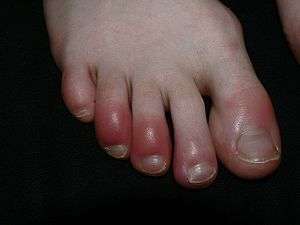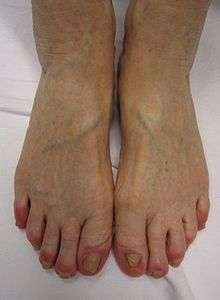Chilblains
| Chilblain | |
|---|---|
 | |
| Toes inflamed by chilblains | |
| Classification and external resources | |
| Specialty | Emergency medicine |
| ICD-10 | T69.1 |
| ICD-9-CM | 991.5 |
| DiseasesDB | 31219 |
| eMedicine | derm/322 |
| MeSH | D002647 |
Chilblains (/ˈtʃɪlbleɪnz/) — also known as pernio and perniosis[1] — is a medical condition that occurs when a predisposed individual is exposed to cold and humidity, causing tissue damage. It is often confused with frostbite and trench foot. Damage to capillary beds in the skin causes redness, itching, inflammation, and sometimes blisters.[2] Chilblains can be reduced by keeping the feet and hands warm in cold weather, and avoiding extreme temperature changes. Chilblains can be idiopathic (spontaneous and unrelated to another disease), but may also be a manifestation of another serious medical condition that needs to be investigated. A history of chilblains is suggestive of a connective tissue disease (such as lupus). Chilblains in infants, together with severe neurologic disease and unexplained fevers, can be seen in Aicardi–Goutières syndrome, a rare inherited condition.
Signs and symptoms

The areas most affected are the toes, fingers, earlobes, nose.
- Blistering of affected area
- Burning and itching sensation in extremities
- Dermatitis in extremities
- Digital ulceration (severe cases only)
- Erythema (blanchable redness of the skin)
- Pain in affected area
- Skin discoloration, red to dark blue
Chilblains usually heal within 7–14 days.
Prevention
Exposure
- Avoid rapid changes in temperature (including from cold to hot).[3]
- Wear warm shoes, socks and gloves.[3]
- Wear a hat and a scarf to protect the ears and the nose.[3]
- Avoid tight fitting socks/shoes.
- Place cotton wool between the toes to improve circulation.[3]
- Recommend soaking in warm water with Epsom salts for 15–20 minutes, 3–4 times a day. Avoid very hot water.
Other
- Healthy diet, low in inflammatory foods
- Exercise at least four times a week to improve circulation[3]
Treatment
- Keep area warm, and avoid any extreme temperature changes (including very hot water).
- Keep affected area dry.[4]
- Use a topical steroid cream to relieve itch.
- Nifedipine, a vasodilator, may be used in more severe or recurrent cases.[5]Vasodilation helps reduce pain, facilitate healing and prevent recurrences.[6] It is typically available in an oral pill but can be compounded into a topical formula.
- Diltiazem, a vasodilator, may also be used.[7]
- Apply a mixture of friar's balsam and a weak iodine solution.[3]
- Avoid restricting the affected area.[8]
- A common tradition of Hispanic America recommends to apply warm garlic on the chilblains. [9]
History
The medieval Bald's Leechbook recommended that chilblains be treated with a mix of eggs, wine, and fennel root.[10]
See also
References
- ↑ James, William D.; Berger, Timothy G.; et al. (2006). Andrews' Diseases of the Skin: clinical Dermatology. Saunders Elsevier. ISBN 0-7216-2921-0.
- ↑ Cold Stress: Chilblains. National Institute for Occupational Safety and Health. Retrieved January 6, 2009.
- 1 2 3 4 5 6 "What are chilblains (pernio)? What causes chilblains?". Medical News Today.
- ↑ "Chilblains.org - #1 Online Source for Treatments, Prevention, Relief Advice". Chilblains.org.
- ↑ Rustin, M.H.A.; Newton, Julia A.; Smith, N.P.; Dowd, Pauline M. (2006). "The treatment of chilblains with nifedipine: the results of a pilot study, a double-blind placebo-controlled randomized study and a long-term open trial". British Journal of Dermatology. 120 (2): 267–75. doi:10.1111/j.1365-2133.1989.tb07792.x. PMID 2647123.
- ↑ Simon, T. D.; Soep, JB; Hollister, JR (2005). "Pernio in Pediatrics". Pediatrics. 116 (3): e472–5. doi:10.1542/peds.2004-2681. PMID 16140694.
- ↑ Patra, AK; Das, AL; Ramadasan, P (2003). "Diltiazem vs. nifedipine in chilblains: A clinical trial". Indian Journal of Dermatology, Venereology, and Leprology. 69 (3): 209–11. PMID 17642888.
- ↑ "Chilblains.com.au - Information, Treatment and Prevention". Chilblains.com.au - Information, Treatment and Prevention.
- ↑ http://www.saludplena.com/index.php/remedios-caseros-para-sabanones/
- ↑ Robert Lacey and Danny Danziger August:The Year 1000: What Life Was Like at the Turn of the First Millennium Little, Brown, 2000 ISBN 0316511579
External links
| Look up chilblains in Wiktionary, the free dictionary. |
| Wikimedia Commons has media related to Chilblains. |
- Cold stress, National Institute for Occupational Safety and Health
-
 "Chilblains". Encyclopædia Britannica. 6 (11th ed.). 1911. p. 134.
"Chilblains". Encyclopædia Britannica. 6 (11th ed.). 1911. p. 134.